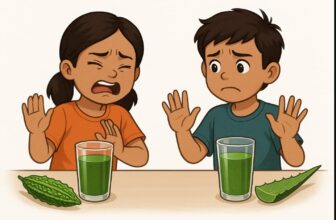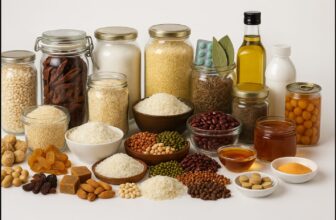Fruits are often seen as guilt-free, but if you’re managing diabetes or trying to lose weight, you can’t treat all fruits equally. Many common fruits in India, like mangoes, bananas, or chikoo, carry more sugar than expected and can work against your health goals if you’re diabetic or watching your weight.
That’s why it’s smart to choose fruits that give you nutrition without spiking your blood sugar or slowing down your weight loss progress. This list focuses on 11 fruits that are low in sugar, easy to digest, and safe to enjoy regularly, with all examples familiar and available across India.
How This Low-Sugar Fruit List Was Chosen
This list isn’t based on trends. It focuses on:
- Fruits with under 10g sugar per 100g
- Low glycemic index (GI) or low glycemic load (GL), so they won’t cause rapid sugar spikes
- Fruits that are easily available across Indian cities and small towns
- Choices that also offer fiber, hydration, or antioxidant benefits that support metabolic health
You’ll find a balance of familiar, local options and a few newer fruits that are now easy to find in India.
11 Low-Sugar Fruits You Can Enjoy Guilt-Free
1. Guava (Amrood)
You can eat guava even if you’re diabetic or following a low-carb diet. It’s crunchy, filling, and packed with vitamin C.
- Sugar: ~5g per 100g
- GI: 15-20
- Why it works: The fiber in guava slows down digestion and stabilizes blood sugar. The fruit keeps you full without adding many calories.
Go for the pink or white-flesh variety, and eat it with the skin for maximum fiber.
2. Jamun (Indian Blackberry)
Jamun is known in Ayurveda for its anti-diabetic effects. You’ll mostly find it during monsoons, sold by street vendors in paper cones.
- Sugar: ~6g per 100g
- GI: Low
- Why it works: It contains jamboline, which may help regulate insulin. Plus, it doesn’t trigger sweet cravings.
If fresh jamun isn’t in season, look for unsweetened jamun powder or dried slices online.
3. Papaya
Papaya feels sweet and soft, but it’s surprisingly low in sugar and high in fiber. It also supports digestion, which is often sluggish in people with metabolic issues.
- Sugar: ~5.9g per 100g
- GI: ~60 (moderate), but low glycemic load
- Why it works: It digests slowly and doesn’t spike blood sugar unless overripe.
Eat a small bowl (100-150g) in the morning, ideally not after a heavy meal.
4. Avocado
Avocados are expensive but valuable for diabetics. They have almost no sugar and contain healthy fats that improve insulin sensitivity.
- Sugar: <1g per 100g
- GI: Extremely low
- Why it works: Avocados help slow digestion and reduce hunger. They’re one of the best fruits for blood sugar control.
Try half an avocado mashed into whole wheat roti or on toast with black salt.
5. Strawberries
When in season, strawberries are a smart pick. They’re naturally low in sugar but still give that sweet taste you might be craving.
- Sugar: ~4.9g per 100g
- GI: ~40
- Why it works: They’re rich in antioxidants that support heart health and have low calories.
If fresh ones are expensive, frozen strawberries (without added sugar) are a good substitute for smoothies.
6. Watermelon (in moderation)
Watermelon has a high glycemic index, but because it’s over 90% water, the glycemic load remains low when you keep the portion small.
- Sugar: ~6.2g per 100g
- GI: High (~72), but low GL
- Why it works: It hydrates and fills you up quickly, making it useful in summer diets.
Stick to a few cubes, not a whole bowl. Avoid pairing it with other carbs.
7. Apple (Indian Varieties Only)
A small Himachal apple with skin can be a good snack, especially when paired with protein or fat. Just don’t go for large imported apples, they’re sweeter.
- Sugar: ~10g per 100g
- GI: ~38
- Why it works: The fiber in the peel slows down sugar absorption. Apples are portable and shelf-stable.
Eat half an apple with a few almonds to reduce the glycemic impact.
8. Pear (Nashpati)
Pears are soft, juicy, and filling. They take time to chew and digest slowly, which is ideal when managing blood sugar.
- Sugar: ~9.8g per 100g
- GI: ~38
- Why it works: High fiber content supports digestion and helps with appetite control.
Eat when slightly firm. Avoid canned or overripe versions that taste sugary.
9. Kiwi
Kiwi offers vitamin C, potassium, and dietary fiber, all in a small, easy-to-eat portion. Despite its taste, it’s not as high in sugar as it seems.
- Sugar: ~8.9g per 100g
- GI: ~50
- Why it works: Low glycemic load makes it safe for most diabetics when eaten whole.
Slice and eat it with skin after washing, this increases fiber intake.
10. Indian Gooseberry (Amla)
Amla is one of the lowest sugar fruits in India. It’s incredibly sour and often eaten with salt or dried. Still, it offers big health benefits.
- Sugar: ~0.6g per 100g
- GI: Very low
- Why it works: It reduces inflammation and supports insulin sensitivity.
Eat it raw in the morning or use a small amount of amla powder in water.
11. Tender Coconut (Malai Only)
Coconut malai (the white jelly inside) is low in sugar, unlike the water. It’s rich in healthy fats and quite filling.
- Sugar (Malai): ~2.1g per 100g
- GI: Low
- Why it works: High-fat content keeps you full longer and stabilizes blood sugar.
Eat fresh malai with a spoon, don’t combine it with honey or jaggery.
Fruits You Should Limit or Avoid
Some fruits are high in natural sugar and can raise your blood glucose, even in small quantities:
| Fruit | Sugar (per 100g) |
|---|---|
| Mango | 13-15g |
| Banana | 12g |
| Grapes | 16g |
| Chikoo | 20g |
| Dates | 63g |
If you still want to eat them occasionally, cut down the portion and don’t combine with other carb-rich foods.
How to Eat Fruits Smartly
Time It Right
Eat fruit between meals, not right after. The best time is:
- Mid-morning (2-3 hours after breakfast)
- Pre or post-workout, especially if you’re active
Avoid fruits late at night or after heavy, carb-rich meals.
Keep the Portion in Check
- Stick to 100-150g of fruit at a time
- Maximum of 2 servings per day
Always Eat Whole Fruits
Avoid fruit juices, even homemade ones. Juicing removes fiber, increases sugar concentration, and causes blood sugar spikes.
Pair Wisely
Combine fruits with healthy fats or protein like:
- Handful of nuts
- Spoonful of peanut butter
- Bowl of plain curd
This slows down sugar absorption and keeps you full longer.
Summary
Managing diabetes or losing weight doesn’t mean giving up fruits. You just need to be selective. The fruits on this list are:
- Low in sugar
- High in fiber or water
- Supportive of blood sugar control and hunger management
By choosing smartly, fruits like guava, jamun, papaya, and amla, you get the benefits of fiber, hydration, and nutrients without triggering a sugar spike. What matters is when you eat, how much you eat, and how you combine it with other foods. Skipping fruit juice, sticking to whole fruits, and avoiding high-sugar varieties like chikoo or dates helps you stay on track.
With the right choices, fruits can still be part of your everyday plate, even on a sugar-restricted plan.





